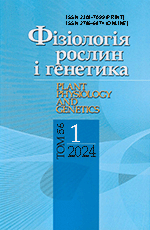Досліджували вплив позакореневого підживлення добривом еколайн фосфітний на фотосинтетичний апарат та продуктивність рослин озимої м’якої пшениці (Triticum aestivum L.) сортів Даринка київська і Джамала, які вирощували у вегетаційних посудинах на 10 кг ґрунту за природних температури й освітлення. Вологість ґрунту в посудинах весь час підтримували на оптимальному рівні (60—70 % повної вологоємності). Рослини сорту Даринка київська обробляли позакоренево препаратом еколайн фосфітний К-Аміно, а сорту Джамала — еколайн фосфітний К у розрахунку 1 л/га двічі: в кінці фази виходу в трубку (ВВСН 39) і формування зернівки (ВВСН 71). Визначення вмісту фотосинтетичних пігментів, інтенсивності газообміну та активності антиоксидантних ферментів хлоропластів прапорцевих листків проводили у фази цвітіння (ВВСН 65) і молочно-воскової стиглості (ВВСН 77), показники зернової продуктивності — у фазу повної стиглості зерна. Показано, що позакоренева обробка рослин озимої пшениці препаратами еколайн фосфітний К і еколайн фосфітний К-Аміно стимулювала фотосинтетичну активність прапорцевого листка, уповільнювала її зниження в ході онтогенетичного розвитку, сприяючи ліпшому забезпеченню асимілятами наливання зернівок, та оптимізувала роботу фотосинтетичного апарату (зниження витрат вуглецю на фотодихання). Виявлені ефекти обробки препаратами можуть бути пов’язані як з праймувальним ефектом фосфіту, зокрема, підвищенням активності антиоксидантних ферментів, що посилює стійкість рослин до дії несприятливих абіотичних і біотичних чинників довкілля, так і з кращим розвитком кореневої системи рослин, а отже — поліпшенням засвоєння елементів мінерального живлення.
Ключові слова: Triticum aestivum L., фосфіт калію, фотосинтез, фотодихання, транспірація, супероксиддисмутаза, аскорбатпероксидаза, зернова продуктивність
Повний текст та додаткові матеріали
У вільному доступі: PDFЦитована література
1. Verma, K.K., Song, X.-P., Kumari, A., Jagadesh, M., Singh, S. K., Bhatt, R., Singh, M., Seth, C.S. & Li, Y.-R. (2025). Climate change adaptation: Challenges for agricultural sustainability. Plant Cell Environ., 48, pp. 2522-2533. https://doi.org/10.1111/pce.15078
2. Mohammed, U., Davis, J., Rossall, S., Swarup, K., Czyzewicz, N., Bhosale, R., Foulkes, J., Murchie, E.H. & Swarup, R. (2022). Phosphite treatment can improve root biomass and nutrition use efficiency in wheat. Front. Plant Sci., 13, 1017048. https://doi.org/10.3389/fpls.2022.1017048
3. Xiaoyun, H., Xi, Y., Zhang, Z., Mohammadi, M.A., Joshi, J., Borza, T. & Wang-Pruski, G. (2021). Effects of phosphite as a plant biostimulant on metabolism and stress response for better plant performance in Solanum tuberosum. Ecotoxico. Environ. Saf., 210, 111873. https://doi.org/10.1016/j.ecoenv.2020.111873
4. Rossall, S., Qing, C., Paneri, M., Bennett, M. & Swarup, R. (2016). A 'growing' role for phosphites in promoting plant growth and development. Acta Hortic., 1148, pp. 61-68. https://doi.org/10.17660/ActaHortic.2016.1148.7
5. Swarup, R., Mohammed, U., Davis, J. & Rossall, S. (2020). Role of phosphite in plant growth and development. School of University of Nottingham, Biosciences, White paper, April. Retrieved from https://www.nottingham.ac.uk › research › swarup...
6. Pacheco-Narcizo, A., Trejo-Tellez, L.I., Hidalgo Contreras, J., Pastrana, R. & GЩmez-Merino, F. (2022). Biostimulation of chayote [Sechium edule (Jacq.) Sw.] in response to the application of phosphite. Rev. fitotec. mex. publ. por la Sociedad Mexicana de Fitogenetica, 45, No. 4, pp. 483-492. https://doi.org/10.35196/rfm.2022.4.483
7. Mayen-Villa, R.I., Morales-Rosales, E.J., Morales-Morales, E.J. & Lopez-Sandoval, J.A. (2023). Rendimiento de tomate (Solanum lycopersicum) en funciЩn de fosfito de potasio como fertilizante foliar. Ecosistemas y Recursos Agropecuarios, 10 (2), e3543. https://doi.org/10.19136/era.a10n2.3543
8. Adaskaveg, J.E., FШrster, H., Hao, W. & Gray M. (2017). Potassium Phosphite Resistance and New Modes of Action for Managing Phytophthora Diseases of Citrus in the United States. In Deising, H.B., Fraaije, B., Mehl, A., Oerke, E.C., Sierotzki, H. & Stammler, G. (Eds), Modern Fungicides and Antifungal Compounds, Vol. VIII, (pp. 205-210), Braunschweig: Deutsche Phytomedizinische Gesellschaft.
9. Havlin, J.L. & Schlegel, A.J. (2021). Review of phosphite as a plant nutrient and fungicide. Soil Syst., 5, 52. https://doi.org/10.3390/soilsystems5030052
10. Wellburn, A.R. (1994). The spectral determination of chlorophylls a and b, as well as total carotenoids, using various solvents with spectrophotometers of different resolution. J. Plant Physiol., 144, pp. 307-313. https://doi.org/10.1016/S0176-1617(11)81192-2
11. Busch, F.A., Ainsworth, E.A., Amtmann, A., Cavanagh, A.P., Driever, S.M., Ferguson, J.N., Kromdijk, J., Lawson, T., Leakey, A.D.B, Matthews, J.S.A., Meacham-Hensold, K., Vath, R.L., Vialet-Chabrand, S., Walker, B.J. & Papanatsiou, M. (2024). A guide to photosynthetic gas exchange measurements: Fundamental principles, best practice and potential pitfalls. Plant Cell Environ., 47 (9), pp. 3344-3364. https://doi.org/10.1111/pce.14815
12. Giannopolitis, C.N. & Ries, S.K. (1977). Superoxide dismutase. Occurrence in higher plants. Plant Physiol., 59, No. 2, pp. 309-314. https://doi.org/10.1104/pp.59.2.309
13. Chen, G.-X. & Asada, K. (1989). Ascorbate peroxidase in tea leaves: occurrence of two isozymes and the differences in their and molecular properties. Plant Cell Physiol., 30, No. 7, pp. 987-998. https://doi.org/10.1093/oxfordjournals.pcp.a077844
14. Pessarakli, M. (Ed.). (2024). Handbook of Photosynthesis (4th Edition). CRC Press. https://doi.org/10.1201/b22922
15. Kovalyshyn, I.B., Shevchenko, V.V. (2020). Phosphate and phosphite: influence on the state of wheat photosynthetic apparatus. Fiziol. rast. genet., 52 (6), pp. 507-517. https://doi.org/10.15407/frg2020.06.507
16. Walker, B., Schmiege, S.C. & Sharkey, T.D. (2024). Re-evaluating the energy balance of the many routes of carbon flow through and from photorespiration. Plant Cell Environ., 47, No. 9, pp. 3365-3374. https://doi.org/10.1111/pce.14949
17. Krieger-Liszkay, A., Krupinska, K. & Shimakawa, G. (2019). The impact of photosynthesis on initiation of leaf senescence. Physiol. Plant., 166, pp. 148-164. https://doi.org/10.1111/ppl.12921
18. Morgun, V.V., Stasik, O.O., Kiriziy, D.A. & Sokolovska-Sergiienko, O.G. (2019). Effect of drought on photosynthetic apparatus, activity of antioxidant enzymes, and productivity of modern winter wheat varieties. Regul. Mech. Biosyst., 10, pp. 16-25. https://doi.org/10.15421/021903
19. Endo, T. & Asada, K. (2008). Photosystem I and Photoprotection: Cyclic Electron Flow and Water-Water Cycle. In Demmig-Adams, B., Adams, W.W. & Mattoo, A.K. (Eds.), Photoprotection, Photoinhibition, Gene Regulation, and Environment (pp. 205-221), Dordrecht: Springer Science+Business Media B.V. https://doi.org/10.1007/1-4020-3579-9_14
20. Walker, B.J., Kramer, D.M., Fisher, N. & Fu, X. (2020). Flexibility in the energy balancing network of photosynthesis enables safe operation under changing environmental conditions. Plants, 9 (3), 301. https://doi.org/10.3390/plants9030301
21. Sun, H., Yang, Y.-J. & Huang, W. (2020). The water-water cycle is more effective in regulating redox state of photosystem I under fluctuating light than cyclic electron transport. Biochim. Biophys. Acta Bioenerg., 1861 (9), 148235. https://doi.org/10.1016/j.bbabio.2020.148235
22. Kedruk, A.S., Kiriziy, D.A., Stasik, O.O., Sokolovska-Sergiienko, O.G. & Tarasiuk, M.V. (2024). Effects of drought on photosynthetic induction in leaves of different wheat genotypes under dark-to-light transition. Regul. Mech. Biosyst., 15 (3), pp. 504-513. https://doi.org/10.15421/022471
